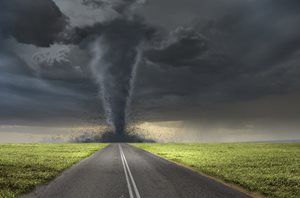(4/11/2022)
We all know the spring weather adages: March is “in like a lion, out like a lamb;” “April showers bring May flowers.” In general, these still hold true, but the traditional seasons we once observed for weather patterns and natural disasters are becoming less defined. While we can anticipate seeing an uptick in flooding across the US and tornadoes are more likely to touch down in the Midwest in the spring, we can’t flip a switch on when to prepare for these disasters.

Due to climate change, natural disasters are occurring year-round and in new regions. More than
60 tornadoes ripped through the South and Midwest in December 2021 killing more than 80 people across eight states. A few months before,
10 tornadoes touched down in New Jersey, Pennsylvania and Maryland. “Tornado season” is not just a spring and summer event, but a year-round, cross-country emergency that can strike at any time.
How do facility managers prepare for something that could strike at any time?
The Data Is Changing
Traditional annual weather data plays a role in projecting risks, but we cannot solely rely on it. Even looking at the tornadoes that struck in the fall and winter of 2021 show that developing an overall emergency assessment based on the previous year is ill-founded.
Climate, and in turn, the weather, are changing. To predict what may occur at a specific facility in a specific region, the
Healthcare and Public Health (HPH) Risk Identification and Site Criticality (RISC) Toolkit can help. This toolkit is an “objective, data-driven all-hazards risk assessment that can be used by public and private organizations within the HPH Sector to inform emergency preparedness planning, risk management activities, and resource investments.” This is a valuable tool for facility managers to assess their individual facility’s risks based on past data and potential future risks, including those that are climate related.
In addition to preparing for specific projected emergencies, facilities should have a base plan to prepare for all emergencies they could face.
Review & Update All Hazards Plans
Whether it is a blizzard or an industrial chemical leak, an All Hazards Plan provides foundational responses to all disasters and ensures facilities respond in the same manner, no matter the disaster. However, even an All Hazards Plan across a nationwide facility system such as Medxcel won’t look the same for every facility. For example, an All Hazards emergency plan in Chicago may have provisions for handling a hurricane, but Gulf Coast facilities will have more specific plans due to the likelihood that a hurricane will strike the coast rather than the middle of the country. Here again, the RISC Toolkit can help identify the top five risk factors and vulnerabilities in an area and prioritize them.
Tornado Preparedness
Tornadoes may not touch down at all facilities, but they may also be more likely than they once were. Having specific tornado guidelines in place if your facility may be at risk for one will be imperative. This goes beyond having a plan written out on paper. Facilities must regularly practice and re-evaluate tornado response plans to ensure leadership teams can respond in a timely, adequate capacity under pressure.
Tornado plans specifically should include considerations such as pre-landfall actions, safe shelter locations, accountability procedures, horizontal and vertical evacuation, building damage assessment, and training practices. It’s also important to make sure that disaster response supplies are accessible during an emergency. Store supplies in multiple locations and have backup fuel or vehicles to account for electric vehicles that may not be able to be charged.
Developing a strong communication infrastructure is also important, as tornadoes can often impact the reliability of these resources. If infrastructure is damaged, alternatives should be in place such as satellite phones, HAM radios, and mass notification systems. Having a unified message and clear communication will prevent miscommunications, especially when social media can spread information quickly during disasters, accurate or not.
There are many more variables to consider when planning for tornados, or natural disasters of any kind. That is why Medxcel integrates daily operations with emergency operations to create whole-hospital accountability and ensure a safe environment for patients, visitors and associates. Learn more about our emergency preparedness and safety program
here.